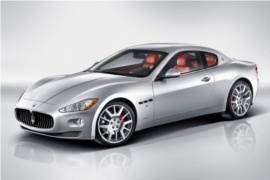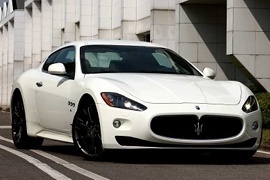
MASERATI GranTurismo
Generations Timeline, Specs and Pictures

The GranTurismo was launched at the 2007 Geneva Motor Show as the successor to the Maserati Coupe.
For the first time in Maserati history it not only has an engine taken out of the Ferrari garage, it also has a Ferrari corresponding model in the shape of the California Roadster/Coupe. Unlike the Maserati Coupe, the GranTurismo no longer uses a transaxle transmission, although the weight distribution is still in an almost perfect 49/51 ratio on the two axels. The V8 engine is the same 4.3 liter V8 from the Coupe/GranSport models, only that it’s been tweaked to achieve 405 hp.

For 2018, the Maserati GranTurismo got a substantial refresh coming with a more sharper design, better aerodynamics, and more interior amenities.
The GranTurismo range has been streamlined for 2018 and two well-defined versions will be offered – Sport and MC. The 4.2-litre GranTurismo has been discontinued, while the Sport and MC share the same powertrain and interior personalization packages. The most striking visual change comes from the new bumpers, grille, and headlights, while the interior gained a new infotainment system, modified dashboard, and standard Harman Kardon premium sound system.

It was the most powerful and the fastest Maserati from the Italian car-maker.
It was the hard-core version of its well-known GT model. And it wasn’t a GT anymore.
Maserati has a long history in motorsports. It won races on most European tracks and its conversion toward GT cars was not unusual. But it still didn’t forget its past and glory. The MC Stradale was just the kind of car that someone would buy for weekend track-days, in the same way, that someone would buy a Porsche Carrera GT3 RS.
The MC Stradale was a stripped-down and rebuilt GranTurismo, with more carbon-fiber, more power, and fewer seats. The exterior look was slightly different than the regular model. It had a new front splitter, bumper, hood, front panels, side sills, exhausts, and even a new rear bumper. Overall, it lost 110 kg (242.5 lbs) from its initial weight.
Inside, most of the soundproofing materials were gone and so were the rear seats. Instead, on the options list, the manufacturer added a roll-cage and four-point racing harness. Some comfort features were kept, such as the air-conditioning, the power-windows, or a basic infotainment system. The car had to be legal to drive on the road, but fierce on a race-track.
The engine was upgraded and offered 10 hp more than the regular GranTurismo and it was mated to a re-tuned 6-speed automatic transmission only.

Unveiled one year after the launch of the Maserati Granturismo, the more powerful S version had a slightly redesigned look and upgraded mechanics.
Aesthetically, the Granturismo S featured grey 20-inch alloys, a blacked-out grille, an extended tail spoiler, dual chromed tailpipes, flared sills and red brake callipers.
The major upgrade though was under the hood, with a new 4.7-liter engine that replaced the 4.2-liter unit. The 500cc increased the power output to 440 hp, compared to 405 hp on the Granturismo.
Quantifiably faster than the Granturismo, the S version could reach 100 km/h in only 4.9 seconds and had a top speed of 295 km/h.
The company’s most powerful car by that time, the Granturismo S was less a grand tourer and more a Sports car. The ZF automatic transmission was replaced by a completely reworked and improved robotised manual transaxle gearbox.
The ride comfort was a little compromised with the stiffer, non-adjustable chassis, as well as with the 20-inch alloys. Adjustable dampers were optional, and the S came with the Maserati’s Skyhook system that allowed the driver to choose the suspension settings straight from the dashboard, depending on the road conditions.
Maserati claimed that the fuel economy was improved by 9%, reaching 11.2 liters/100km in the extra-urban traffic.























































